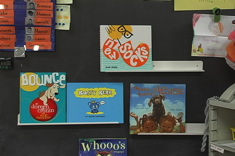I plan author studies for my students at the start of the year. I think about the range of authors we might study, what authors work best at different times of the year, and especially, how the author studies can be a springboard into building our community of readers.
It’s important to me that the author studies include meaningful reading, writing, and discussion activities. Anyone who knows me knows I avoid the cutesy author studies art activities that can be fun but have little or no connection to the books. I haven’t found that random craft projects deepen students’ awareness of reading and writing. Instead, we take the time to write and talk about text features, the author’s writing craft, and themes in the book in ways that help students understand their own emerging skills as readers and writers.
We do lots of writing connected to the author studies: whole-class anchor charts, three-section grids of plot or character analysis, and letters to the authors. We do many of these activities with teachers and students from other classrooms in our school. Sharing author studies is a wonderful way to build connections to other students and teachers. We are sometimes surprised at the similarities or differences in our responses to different authors.
The author studies in our school are a continual source of opportunities for collaboration among different teachers as we talk about reading, writing, and children’s books we enjoy. The planning template I’ve provided here includes places to note key books to use, response activities, and ways to use the author studies to build connections with other teachers and students.
To download the four-page planning template, click here.



